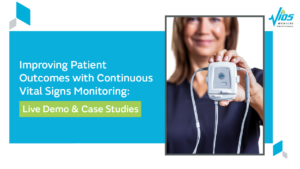
Q&A: The impact of continuous vital signs monitoring in post-acute cardiac care
Delivering the highest standard of care means that post-acute care teams need to quickly adapt to the day-to-day health changes of their patients.
Shane Martensen, PA-C, is a Physician Assistant at Suffolk Cardiac Care, a private practice in New York. He works with several skilled nursing facilities and subacute rehabs, delivering cardiac care to patients with complex health histories. He graduated from Molloy University with a Bachelor of Science in Biology, followed by a Master of Science in Physician Assistant Studies from Touro University.
In this Q&A, Martensen shares his experience working with the Vios Monitoring System and how it has expanded in-patient treatment options in post-acute care.
How long have you been working with the Vios Monitoring System? What types of patients have you treated using the system?
I’ve been working with the Vios system since June 2021 in one of the facilities that our practice works with. We’ve used the system on patients that were admitted to the hospital and are now being discharged to a subacute rehab. They’re not able to perform daily activities and are still too sick to go home, so they are at rehab to get stronger, to get better and hopefully go home with improved strength.
There are patients with orthopedic problems, most commonly, broken hips or a spine compression fracture. These patients may have a history of underlying cardiac conditions, such as atrial fibrillation (A-fib), congestive heart failure and coronary artery disease, and they benefit highly from use of the Vios Monitoring System.
How do you use the Vios Monitoring System? How do you see it differentiating what you do and how you care for your patients?
We review arrhythmias through the Vios Monitoring System. I have access to the Vios system outside of the office. For instance, a nurse may call me about a patient with tachycardia to help determine the underlying rhythm, which will dictate management. Having access to Vios allows us to review the arrhythmia strip and determine a diagnosis such as sinus tachycardia, atrial fibrillation with rapid ventricular response, supraventricular tachycardia (SVT), etc., which will help us choose the appropriate treatment options.
In other cases, we have patients with A-fib that have slow heart rates or pauses that may require pacemakers at some point in the course of this disease. This can also be detected through the use of the Vios Monitoring System. We can appropriately adjust their cardiac medications to avoid significant side effects such as low heart rate and can determine if they need an outpatient Electrophysiologist consultation for consideration of a pacemaker. This may help avoid a hospital visit by using Vios to record and document the concerning arrhythmias, at which time patients can be evaluated further by an Electrophysiologist.
The Vios Monitoring System allows us to continue to optimally manage the patient at the facility without necessarily having to transfer the patient to the emergency room.
Do you have any rules of thumb on which patients use the Vios Monitoring System?
Generally, the Vios Monitoring System is indicated in patients with symptoms such as palpitations or dizziness, along with chronic cardiac conditions such as history of arrhythmias like atrial fibrillation. For example, if they had new onset A-fib with rapid ventricular response (RVR), we will use the Vios system. We have diagnosed new onset A-fib and high degree heart blocks in a subacute rehab setting with the Vios telemetry system that allows us to recommend expedited and effective management options.
Patients often pass out or syncopize while at rehab, and to avoid hospitalizations and to rule out a cardiac cause, we use the Vios telemetry monitor for a few days to rule out an arrhythmia. We can also order further testing such as an echocardiogram to complete a cardiac work-up.
For congestive heart failure patients, they are at risk or often have a history of arrhythmias, so they may benefit from telemetry monitoring. This is important especially as the patient restarts activity/rehabilitation exercises. Subsequently, if there are significant arrhythmias noted, this will allow us to dictate appropriate management, such as adjustment of beta-blockers, and monitor their progress closely.
Do you use certain indicators to monitor where you are at with meds and what direction you need to go?
Using the Vios system is a good way of monitoring the important vital signs of the patient and to try to stabilize should there be a clinical deterioration. Continuous monitoring allows early detection of concerning arrhythmias, respiratory distress or hemodynamic instability which will, in turn, allow for early risk stratification and treatment, including optimization of cardiac medications that can be adjusted through the course of rehabilitation and recovery.
How has the Vios Monitoring System changed your work routine and your efficiency for doing what you must do?
We start the day at the rehabilitation facility by speaking with the patients, followed by physical examination, after which, we go to the telemetry unit to review events that have happened in the past 24 hours or more. These events may include changes in heart rate or respiratory rate that allows us to follow up with the patients and dig further into possible symptoms at the time of any events. Vios systems are essential in helping to diagnose the arrhythmia but also to assess how often the arrhythmia occurs and what treatment is required, especially during and after rehab exercises.
Moreover, even when we are not on site, Vios allows us the capability to check remotely for arrhythmias by signing into the system. This is useful especially for any symptoms or events overnight. It gives me confidence because I know exactly what is happening, and this can help avoid unnecessary hospitalization or Emergency Department visits. At facilities where the Vios Monitoring System is unavailable, more often than not, patients are immediately transferred to the Emergency Department for tachycardias or bradycardias.
What have patients said about the system?
Patients have noted that this is a state-of-the-art, compact device that does not interfere with their rehabilitation exercises. They have mentioned that they are comfortable wearing it, without associated rashes or discomfort. Moreover, they feel secure that given the possible prior cardiac history, their heart activity is being monitored, like cardiac rehabilitation. Heart failure patients are aware of their high rehospitalization rates. Patients, families, and providers like the peace of mind that wearing a Vios monitor brings to the table. This allows us to utilize the advantages of the Vios system in the facilities as we try to maximize their health and rehabilitation.




